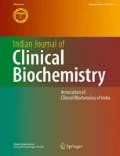Abstract
Free radical mediated pathological processes may have a role in schizophrenia. Free radicals (oxy radicals, such as superoxide, hydroxyl ions and nitric oxide) cause cell injury, when they are generated in excess or when the antioxidant defense is impaired. Both these processes seem to be affected in schizophrenia. In this study we investigated erythrocyte superoxide dismutase (SOD) and catalase (CAT) activities as antioxidant enzymes, malondialdehyde (MDA) as a sign of lipid peroxidation in schizophrenic patients. Activities of superoxide dismutase, catalase and malondialdehyde were greater in patients compared with the control group which may reflect increased oxidative stress in the brain tissue of schizophrenics. In the patient group erythrocyte SOD and CAT activities were weakly negative correlated with MDA concentration. These data reveal that antioxidant defense mechanisms might be impaired in schizophrenic patients. These findings also provide a theoretical basis for the development of novel therapeutic strategies, such as antioxidant supplementation.
Similar content being viewed by others
References
Halliwell, B. (1992) Reactive oxygen species and the central nervous system. J. Neurochem. 59, 1609–1623.
Lohr, J.B. (1991) Oxygen radicals and neuropsychiatric illness: some speculations. Arch. Gen. Psychiatr. 48, 1097–1106.
Reddy, R.D. and Yao, J.K. (1996) Free radical pathology in schizophrenia. Prostaglandins Leukot. Essent. Fatty acids 55 (1–2), 33–43.
Cadet, J.L. and Kahler, L.A. (1994) Free radical mechanisms in schizophrenia and tardive dyskynesia. Neuro. Sci. Biobehav. Res. 18 (4), 457–467.
Dusica, P. and Vesna, T. (2002) Oxidative stress as marker of positive symptoms in schizophrenia. Facta Universitatis. Medicine & Biology. 9 (2), 157–161.
Mahadik, S.P. and Scheffer, R.E. (1996) Oxidative injury and potential use of antioxidants in schizophrenia. Prostag. Leuko. Ess. 55, 45–54.
Satoh, K. (1978) Serum lipid peroxide in cerebrovascular disorders determined by new colorimetric method. Clin. Chem. Acta 90, 37–43.
Wasowicz, W., Neve, J and Peretz, A. (1993) Optimised Steps in Flourimetric Determination of Thiobarbituric Acid reactive substances in serum: Importance of extraction pH and influence of sample preservation and storage. Clin. Chem. 39 (12), 2522–2526.
Stocks, J. and Dormondy, T.L. (1971) The auto oxidation of human red cell lipids induced by hydrogen peroxide. Br. J. Haematol. 20, 95–111.
Mc Cord and Fridovich, I. (1969) Superoxide dismutase on enzymatic function for erythrocumein. J. Biol. Chem. 24, 6049–6055.
Beauchamp, C. and Fridovich, I. (1971) Superoxide dismutase: Improved assays and an assay applicable to acrylamide gels. Anal. Biochem. Review. 44, 276–287.
Sun, Y., Oberley, L.W. and Li, Y. (1988) A simple method for clinical assay of superoxide dismutase. Clin. Chem. 34, 497–500.
Brannan, T.S., Maker, H.O. and Raess, I.P. (1981) Regional distribution of catalase in adult rat brain. J. Neurochem. 86, 307–309.
Sinet, P.M., Heikkila, R.E. and Cohen, G. (1980) Hydrogen peroxide production from rat brain in vivo. J. Neurochem. 34, 1421–1428.
Drabkin, D.L. et al. (1932). J. Biochem. 98, 719.
Nikushkin, E.V., Kryzhanovski, G.N., Tupeer, I.R., Bordyukov, M.M. and Yuzefova, S.M. (1987). Blood antioxidant enzymes during epileptic activity. Bull. Ekesp. Biol. Med. 3, 297–299.
Smith, C.D., Carney, J.M., Sturke Reed, P.E., Oliver, C.N., Stadman, E.R., Floyd, R.A. and Markesbery, W.R. (1991) Excess brain protein oxidation and enzymes dysfunction in normal aging and in Alzheimer disease. Proc. Natl. Acad. Sci. USA. 88, 10540–10543.
Abdulla, D.S.P., Monteiro, I.I.P., Oliveira, J.A.C. and Bechara, E.J.H. (1986) Activities of Superoxide dismutase and glutathione peroxidase in Schizophrenic and manic depressive patients. Clin. Chem. 32 (5), 805–807.
Halliwell, B. (1989) Oxidants and central nervous system. Some fundamental questions. Acta. Neurol. Scand. 126, 23–33.
Glenberg, A.J., Bassuk, E.L. and Schoonover, S. (1991) The practitioner's guide to Psycho active drugs. New York Plenum Publishing Co. 143.
Reddy, R., Mahadik, P.S., Sukdeb, M. and Jayasimha, N.M. (1991) Enzymes of the Antioxidant Defense System in Chronic Schizophrenic Patients. Biol. Psychiatry. 30, 409–412.
Yao, J.K., Ravinder, D.R. and Daniel, P. van Kammen. (1999) Human Plasma Glutathione Peroxidase and Symptom Severity in Schizophrenia. Biol. Psychiatry. 45, 1512–1515.
Janero, D.R. (1990) Malondialdehyde and thiobarbituric acid reactivity as diagnostic indices of lipid peroxidation and peroxidative tissue injury. Free radical Bio. Med. 9, 515–540.
Pall, H.S., Williams, A.C., Blake, D.R. and Lunec, J. (1987) Evidence of enhanced lipid peroxidation in cerebrospinal fluid of patients taking phenothiazines. Lancet. 72, 535–539.
Mc. Credie, R.G., Mac Donald, E., Wiles, D., Campbell, G. and Peterson, J.R. (1995) The Nithsdale Schizophrenia Survey. XIV: Plasma lipid peroxide and serum Vitamin E levels in patients with and without tardive dyskinesia and in normal subjects. Br. J. Psychiatry 167, 610–617.
Benedicta, D. and Vivian, D. (2003) Oxidative injury and antioxidant vitamins E and C in Schizophrenia. Ind. J. of Clin. Biochem. 18 (1), 87–90.
Strunecka, A. and Ripova, D. (1999) What can the investigation of phosphoinositide signaling system in platelets of schizophrenic patients tell us? Prostaglandins Leukot Essent Fatty Acids. 61 (1), 1–5.
Heales, S.J.R., Barker, J.E., Stewart, V.C., Brand, M.P., Hargreaves, I.P., Land, J.M., Clark, J.B. and Bolanos, J.P. (1997) Nitric oxide energy metabolism and neurological disease. Biochem. Soc. Trans. 25 (3), 939–943.
Author information
Authors and Affiliations
Rights and permissions
About this article
Cite this article
Rukmini, M.S., D'Souza, B. & D'Souza, V. Superoxide dismutase and catalase activities and their correlation with malondialdehyde in schizophrenic patients. Indian J Clin Biochem 19, 114–118 (2004). https://doi.org/10.1007/BF02894268
Issue Date:
DOI: https://doi.org/10.1007/BF02894268




